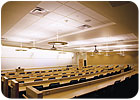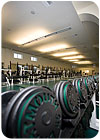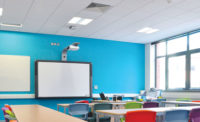
One of the first nine colleges in the United States to be founded before the American Revolution, Dartmouth College in Hanover, N.H., has been part of the nation’s higher education landscape since 1769. With such a long and esteemed history, Dartmouth stands as a fine example of the phrase “built to last,” and the school applies this adage to new construction.
“Built to last” is one reason why Dartmouth College has strongly embraced the concept of sustainable design for all of its buildings. When the college planned the construction of the Floren Varsity House, a new training facility for varsity athletes, LEED NC 2.2 was the building standard it chose to follow. The school hired Centerbrook Architects and Planners, LLC, of Centerbrook, Conn., to design the facility, and Daniel O’Connell’s Sons Inc., of Holyoke, Mass., as construction manager.

THE LEED STANDARD
“Dartmouth College pays close attention to sustainability with all of our buildings, so we’re very familiar with LEED-certified projects,” said Mary Bourque, project manager for the college’s Office of Planning, Design & Construction. “Using the LEED standard made good sense. Plus, our construction manager had just finished a successful LEED project, so we were confident that this would be a good plan for Floren Varsity House.”Centerbrook Architects and Planners created a facility that would provide high-tech athletic training in an energy-efficient, sustainable building. The first floor features a large “smart” classroom equipped with computer and audiovisual equipment, the varsity football locker room, and equipment and training support spaces. The second floor has a 10,000 square-foot strength training room serving all of its varsity athletic teams. The third floor has a large dividable classroom, coaches offices, a football lounge, an athlete study lounge and office, in addition to meeting spaces for athletic staff and coach locker rooms. The facility also includes a mezzanine level, which is used primarily for handicapped access to the adjacent existing football stands.
The architects incorporated several sustainable design features in compliance with LEED NC 2.2 guidelines, including daylight simulation and a heat recovery drain system. One of the standout features of sustainable design is an expansive ceiling cloud in the training room designed with 2 by 8-foot CertainTeed Ecophon Focus D coupled with the Ecophon Focus Wing perimeter treatment and 2 by 2-foot Ecophon Gedina E high-performance ceiling panels.
“We specified the Ecophon ceiling panels for their high quality, refined appearance and light reflectivity,” said Chad Floyd, lead architect for the project. “Also, their high recycled content was very important for attaining the LEED Materials and Resources (MR) credit.”
THE DROPPED CEILING
The ceiling drops down about two feet. “We wanted to accentuate the room’s impressive volume by having a dropped ceiling echo the shape of the room,” Floyd said. “This dropped plane is surrounded by a raised soffit. We used 2 by 8 foot ceiling tiles spanning the shorter lengths of the room. The Focus Wing is cantilevered along the outside perimeter of the suspended ceiling and obscures the structure of the ceiling from view, giving the impression that the entire monolithic assembly is floating over the athletes.”Construction began in April 2006, and the facility was ready for interior work by February 2007. J&J Finishes Inc., of Woburn, Mass., was hired to hang the drywall and install ceiling panels. Using a crew of two, the firm began work in March 2007, starting with the elevator lobby areas for each of the three floors and the mezzanine level. In total, this called for 1,100 square feet of 2 by 2-foot panels with a wing perimeter. The crew then began work on the expansive strength training room.
Between March and September, the crew installed 14,000 square feet of the Ecophon Gedina E panels and 7,000 square feet of the Ecophon Focus D and Wing to create the unique ceiling cloud. Working on a ceiling cloud of this size proved challenging at times, said Jay Grieves, owner of J&J Finishes.
“The biggest challenge was keeping the ceiling straight while it was floating in the air,” he said. “We had to use plenty of lateral bracing, but we got through it.”
In some cases, the crew needed to cut tiles to fit into the design, which allowed fiberglass insulation facing to be visible at the perimeter edge. The manufacturer offered assistance, though, in the form of on-site technical support from a project coordinator. He answered contractor questions and provided hands-on coaching. With his assistance, the project was able to move along more smoothly. Grieves was pleased with the outcome and with his experience with the Ecophon ceiling products.
“The technical coordinator was very helpful to us,” Grieves said. “The project went well and the ceilings look fantastic.”
Dartmouth held a dedication ceremony Nov. 17 for the facility and has received much positive feedback for all of its features, including the showpiece ceiling cloud in the strength training room.
“Overall, we are very pleased,” Bourque said. “The second floor ceiling looks wonderful. It has a really nice, finished look, and it really adds to the atmosphere.”



